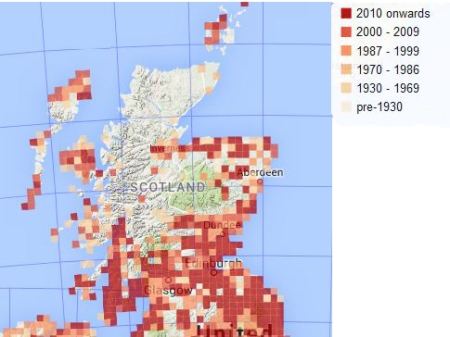Butterbur (Petasites hybridus) has an interesting distribution in Scotland:

As you can see, it is quite widespread on Skye. It is at its most impressive as one leaves Broadford on the Heaste road where later in the summer the huge umbrella-like or rhubarb-like leaves smother everything else over a considerable area.
On Raasay it was reported from “Under the cliff at Brochel” in the 1930s and it is still there today – just a handful of plants.
This plant is flowering now and later in the year develops the largest leaves of any native British plant. Petasites originates from the Greek for a hat with a wide brim worn by farmers in ancient Greece and one can see why.
In the UK the plant is basically dioecious and the male plant is frequent throughout most of British Isles, common in the north, whereas the female plant is frequent in North & Central England, but very sporadic elsewhere. It has been suggested that this odd distribution is the result of deliberate introduction of the female plant to provide early nectar for honey bees
Other members of the genus are not native and include White Butterbur (Petasites albus) which is known in the vice-county only from Isleornsay. I was reminded of it today when I spotted some at Drumnadrochit:
It is well known along watercourses in the Inverness area but this appears to be a new site.
Petasites japonicus (Giant Butterbur) is not known in our area but is known from two areas on Mull.
A fourth species of Petasites is the winter heliotrope (P. fragrans). There is a record from Skye dating from 1970-1986 in NG72, which is the Kyleakin area. An update on this would be much appreciated! Flowering is likely to be over by now.
Tags: Plants


April 8, 2016 at 8:12 pm |
Do you have more details on the location of P. fragans in the Kyleakin area?
April 8, 2016 at 9:08 pm |
No, sorry Steve. All I have is NG72 VC104.
April 9, 2016 at 1:46 pm |
I’ll bear it in mind if I’m in the area and then perhaps do a more thorough search next winter.